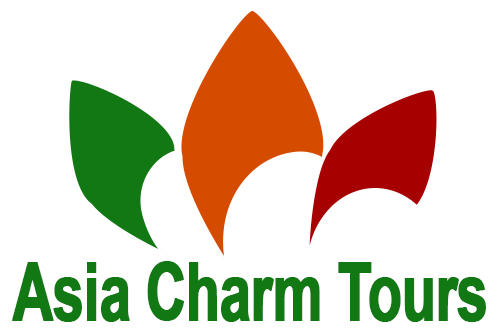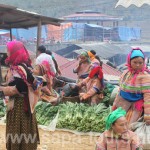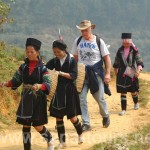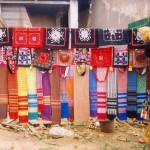The custom of marriage in Sapa Vietnam – H’Mong Ethnic Group ( Part 1)
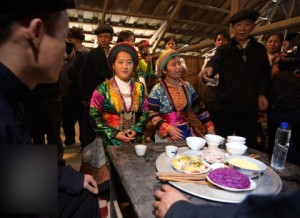 Tourists to Sapa are most attracted by its unique customs, including the custom of marriage.
Tourists to Sapa are most attracted by its unique customs, including the custom of marriage.
Tourists to Cat Cat are most attracted by its unique customs, including the custom of “pulling wife” of H’mong people. A man can ask his friends to lure a girl he likes to his house and keeps her there in three days.
During these days, if the girl agrees to become his wife, a wedding will be held. However, the girl can happily go home after three days if she does not like him.
Clan groups are exogamous: that is, Hmong may not marry within their own clan group; a marriage partner must be found from another clan.
For example, a Xiong may not marry another Xiong.
However, they are allowed to marry blood relatives from their mother side (Neejtsa), for example the children of a brother and sister can marry because they would be from different clans.
Traditionally, when a boy wants to marry a girl, he will make his intentions clear, and will “snatch” (zij) her during day light or night at any opportunity that is appropriate. This is traditionally only a symbolic kidnapping.
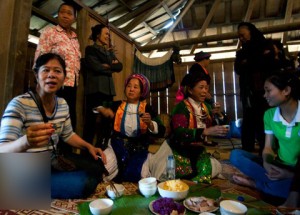
Before kidnapping her, the boy must first give a gift to the girl whom he wants to marry. After a couple of days, the boy can then kidnap the girl. If the boy has never given a gift to the girl, she is allowed to refuse and go back home with any family member who comes to save her.
It should be noted that this is an old tradition that is rarely practiced today. The parents are not notified at the time of the kidnapping, but an envoy from the boy’s clan is sent to inform them of the whereabouts of their daughter and her safety (fi xov).
This envoy tells the girl’s family the boy’s background and asks what the girl’s background is. For example, the envoy may tell the girl’s family that the groom is from a Stripe Hmong family from Luang Prabang, Laos; the bride’s parents reply that they are Moob Leej/Mong Leng from Nong Het, Xieng Khouang, Laos.
Before the new couple enters the groom’s house, the father performs a blessing ritual, asking the ancestors to accept her into the household (Lwm qaib). The head of the household moves the chicken in a circular motion around the couple’s head. The girl is not allowed to visit anyone’s house for three days after this.
After three days or more, the parents of the groom prepare the first wedding feast for the newlywed couple (hu plig nyab tshiab thaum puv peb tag kis). The wedding is usually a two-day process. The couple returns to the house of the bride’s family at the end of the first wedding feast and spends the night in preparation for the next day.
On the second day, the family of the bride prepares a second wedding feast at their home, where the couple will be married (Noj tshoob). Hmong marriage customs differ slightly based on cultural subdivisions within the global Hmong community, but all require the exchange of a bride price from the groom’s family to the bride’s family.
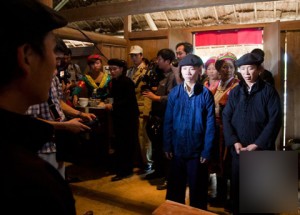
The bride price is compensation for the new family taking the other family’s daughter, as the girl’s parents are now short one person to help with chores. (The price of the girl can vary based on her value or on the parents.) The elders of both families negotiate the amount prior to the engagement and is usually paid in bars of silver or livestock.
Today, it is also often settled in monetary terms. The usual price of a Hmong bride today in America would just depends on the parents or the value of the bride but mostly parents made the wages but some wages are up to$5 grand.
Before the bride and the grooms visit the bride’s family, she must wear the grooms’ traditional clothes example: a Hmong Leng girl married to a Stripe Hmong boy she must wear the stripe clothes to visit her families. After the wedding, the bride will be given farewell presents and sets of new clothes by her parents.
Also she will be wearing her birth families side traditional clothes example: the bride visits her parents by wearing stripe traditional clothes but when she is going back to the grooms place she must wear her Hmong Leng outfits. She will also be given food for the journey.
When departing, the bride’s family members would offer drinks (beer) to the groom until he can no longer drink. An example of this is, an older brother or uncle of the bride would offer the drink and before doing so, he would say a couple of words to his soon to be brother-in law/son-in law that since he (the groom) now has their sister/daughter, he must promise to treat her well and never hit her, etc. Finishing the drink is proof of the groom keeping his promise. Most of the time, the groom would bring his brothers to come help him drink.
However, the groom would never leave without being drunk.
When the couple leaves the bride’s house and return to the husband’s house, another party is held to thank the negotiator(s), the groomsman and brides maid (tiam mej koob).
Continue…
Also see:
- Sin Chai village
- Tram Ton Pass
- Ta Van Village – A pure gem of Sapa
- The Nung and Tu Si house with tranditional baked clay roof tiles
- Beauty of mist in Ham Rong Mount
- Church singing in early spring in Ta Phin
- Sour noodle soup – Upland unique cuisine in Sapa
- Story about unique horse-drawn carriage in Bac Ha
- Bird Market in Muong Khuong village
- Plum flowers blossom in Bac Ha during February.
- Sapa Pau Play Day Cake
- Salmon in Sapa


